Gary Nichols. Sedimentology and Stratigraphy(Second Edition)
Подождите немного. Документ загружается.

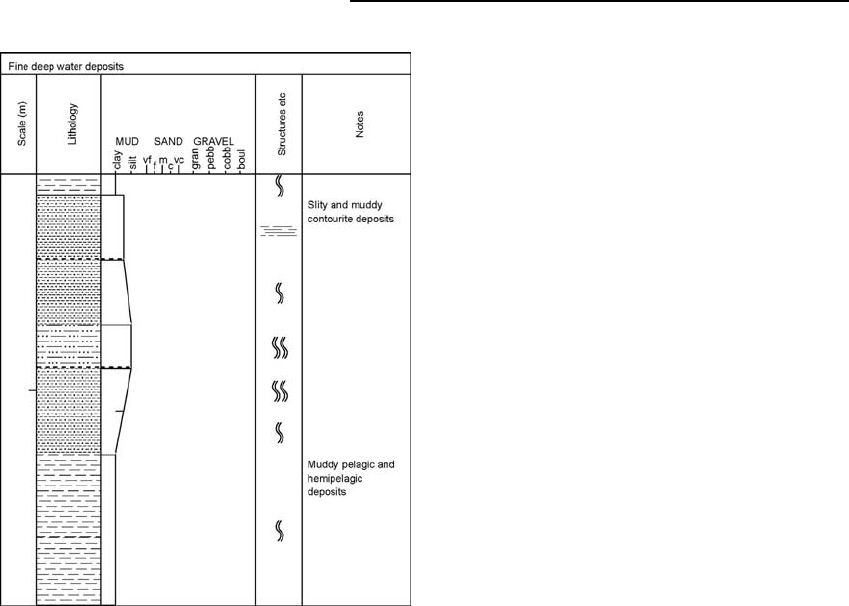
deposited by a turbidite: this may be possible where
there is a difference in composition between the sedi-
ment being transported down the continental slope by
turbidite currents and sediment being transported
parallel to the slope by bottom currents (Stow 1979;
Stow & Lovell 1979).
16.5 OCEANIC SEDIMENTS
16.5.1 Pelagic sediments
The term pelagic refers to the open ocean, and in the
context of sedimentology, pelagic sediments are
made up of suspended material that was floating in
the ocean, away from shorelines, and has settled on
the sea floor. This sediment comprises terrigenous
dust, mainly clay and some silt-sized particles blown
from land areas by winds, very fine volcanic ash,
particularly from major eruptions that send fine ejecta
high into the atmosphere, and airborne particulates
from fires, mainly black carbon. It also includes bio-
clastic material that may be the remains of calcareous
organisms, such as foraminifers and coccoliths, and
the siliceous skeletons of Radiolaria and diatoms
(3.3). All of these particles reside in the ocean water
in suspension, moved around by currents near to the
surface, but when they reach quieter, deeper water
they gradually fall down through the water column to
settle on the seabed.
The origin of the terrigenous clastic material is air-
borne dust (it is aeolian, 8.6.2), and much of this is
likely to have come from desert areas. The particles
are therefore oxidised and the resulting sediments
are usually a dark red-brown colour. These ‘red
clays’ are made up of 75% to 90% clay minerals and
they are relatively rich in iron and manganese. They
lithify to form red or red-brown mudstones. These
pelagic red mudrocks are a good example of how the
colour of a sedimentary rock should be interpreted
with caution: it is tempting to think of all red beds
as continental deposits, but these deep-sea facies are
red too. The accumulation rate of pelagic clays is very
slow, typically only 1 to 5 mm kyr
1
, which means it
could take up to a million years of continuous sedi-
mentation to form just a metre of sediment.
Pelagic sediments with a biogenic origin are the
most abundant type in modern oceans, and two
groups of organisms are particularly common in mod-
ern seas and are very commonly found in strata of
Mesozoic and Cenozoic age as well. Foraminifera are
single-celled animals that include a planktonic form
with a calcareous shell about a millimetre or a frac-
tion of a millimetre across. Algae belonging to the
group chrysophyta include coccoliths that have sphe-
rical bodies of calcium carbonate a few tens of
microns across (3.1.3); organisms this size are com-
monly referred to as nanoplankton. The hard parts of
these organisms are the main contributors to fine-
grained deposits that form calcareous ooze on the
sea bed: where one group is dominant the deposits
may be called a nanoplankton ooze or foramini-
feral ooze. Calcareous oozes accumulate at rates ten
times that of pelagic clays, around 3 to 50 mm kyr
1
(Einsele 2000). This sediment consolidates to form a
fine-grained limestone, which is a lime mudstone
using the Dunham Classification (3.1.6), although
these deposits are often called pelagic limestones.
The foraminifers are normally too small to be seen
with the naked eye, and the coccoliths are only recog-
nisable using an electron microscope.
Fig. 16.12 Schematic graphic sedimentary log through
contourite deposits.
258 Deep Marine Environments
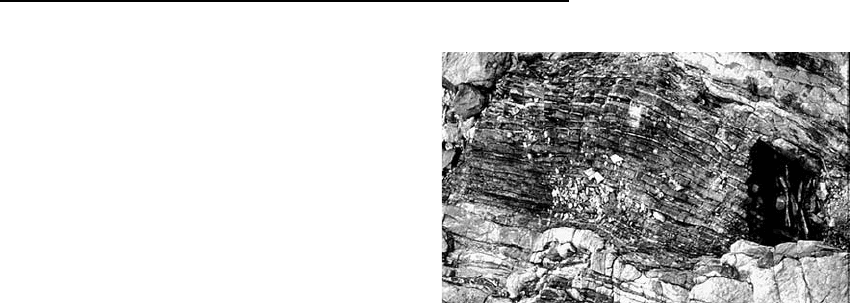
An electron microscope is also required to see any
details of the siliceous biogenic material: diatoms are
only 5 to 50 mm across while Radiolaria are 50 to
500 mm, so the larger ones can be seen with the naked
eye. They are made of opal, a hydrated amorphous
form of silica that is relatively soluble, and diatoms in
particular are often dissolved. Accumulations of this
material on the sea floor are known as siliceous ooze
and they form more slowly than calcareous oozes, at
between 2 and 10 mm kyr
1
. Upon lithification sili-
ceous oozes form chert beds (3.3). The opal is not stable
and readily alters to another form of silica such as
chalcedony, which makes up the chert rock. Deep sea
cherts are distinctive, thinly bedded hard rocks that
may be black due to the presence of fine organic
carbon, or red if there are terrigenous clays present
(Fig. 16.13). The Radiolaria can often be seen as very
fine white spots within the rock and where this is the
case they are referred to as radiolarian chert. These
beds formed from the lithification of a siliceous ooze
deposited in deep water (primary chert) should be
distinguished from chert formed as nodules due to a
diagenetic silicification of a rock (secondary chert:
18.2.3). Secondary cherts are developed in a host
sediment (usually limestone) and have an irregular
nodular shape: they do not provide information about
the depositional environment but may be important
indicators of the diagenetic history.
16.5.2 Distribution of pelagic deposits
Pelagic sediments form a significant proportion of the
succession only in places that do not receive sedi-
ment from other sources, so any ocean areas close to
margins tend to be dominated by sediment derived
from the land areas, swamping out the pelagic depos-
its. The distribution of terrigenous and bioclastic
material on the ocean floors away from the margins
is determined by the supply of the airborne dust, the
biogenic productivity of carbonate-forming organ-
isms, the productivity of siliceous organisms, the
water depth and the ocean water circulation (Einsele
2000). The highest productivity of the biogenic
material is in the warmer waters near the Equator
and also in areas where there is a good supply of
nutrients provided by ocean currents. In these
regions there is a continuous ‘rain’ of calcareous
and, to a much lesser extent, siliceous biogenic
material down towards the sea floor: this ‘rain’ is
less intense in cooler regions or areas with less
nutrient supply.
The solubility of calcium carbonate is partly depen-
dent on pressure as well as temperature. At higher
pressures and lower temperatures the amount of cal-
cium carbonate that can be dissolved in a given mass
of water increases. In oceans the pressure becomes
greater with depth of water and the temperature
drops so the solubility of calcium carbonate also
increases. Near the surface most ocean waters are
near to saturation with respect to calcium carbonate:
animals and plants are able to extract it from sea-
water and precipitate either aragonite or calcite in
shells and skeletons. As biogenic calcium carbonate
in the form of calcite falls through the water column it
starts to dissolve at depths of around 3000 m and in
most modern oceans will have been completely dis-
solved once depths of around 4000 m are reached
(Fig. 16.14). This is the calcite compensation
depth (CCD) (Wise 2003). Aragonite is more soluble
than calcite and an aragonite compensation depth
can be defined at a higher level in the water column
than a calcite compensation depth (Scholle et al.
1983). The calcite compensation depth is not a con-
stant level throughout the world’s oceans today. The
capacity for seawater to dissolve calcium carbonate
depends on the amount that is already in solution, so
in areas of high biogenic productivity the water
becomes saturated with calcium carbonate to greater
depths and higher pressures are required to put
the excess of ions into solution. The depth of the
CCD is also known to vary with the temperature of
the water and the degree of deep water circulation
that is present.
Fig. 16.13 Thin-bedded cherts deposited in a deep marine
environment.
Oceanic Sediments 259
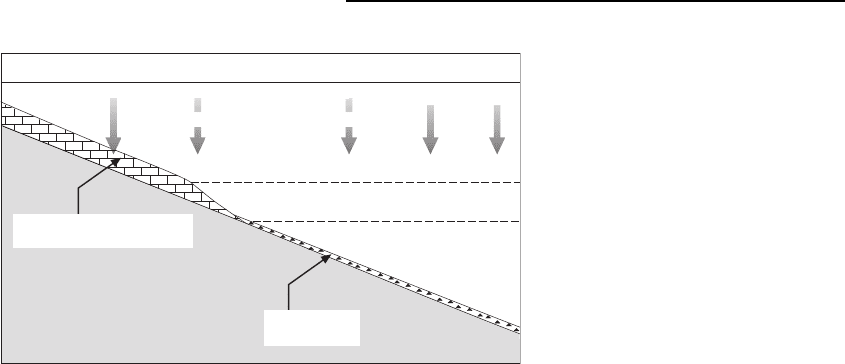
Above the CCD the remains of the less abundant
siliceous organisms are swamped out by the carbonate
material; below the CCD the skeletons of Radiolaria
can form the main biogenic component of a pelagic
sediment (Stow et al. 1996). High concentrations of
siliceous organisms need not always indicate deep
waters. The cold waters of polar regions favour dia-
toms over calcareous plankton and in pre-Mesozoic
strata calcareous foraminifers and nanoplankton are
not present. At water depths of around 6000 m the
opaline silica that makes up radiolarians and diatoms
is subject to dissolution because of the pressure and an
opal compensation depth (or silica compensation
depth) can be recognised.
In the deepest ocean waters it may be expected
that only pelagic clays would be deposited. In some
parts of the world’s oceans this is the case, and there
are successions of red-brown mudrocks in the strati-
graphic record that are interpreted as hadal (very
deep water) deposits. In some instances, these deep-
water mudstones include thin beds of limestone and
chert: radiolarian chert beds also sometimes include
thin limestone beds. The occurrence of these beds
might be explained in terms of fluctuations in the
compensation depths, but a simpler explanation is
that these deposits are actually turbidites and this
can be verified by the presence of a very subtle
normal grading within the beds. Carbonate, for
example, can be deposited at depths below the CCD
if it is introduced by a mechanism other than settling
through the water column. If the material is brought
into deep water by turbidity currents it will pass
through the CCD quickly and will be deposited
rapidly. The top of a calcareous turbidite may
subsequently start to dissolve at the sea floor, but
the waters close to the sea floor will soon become
saturated with the mineral and little dissolution of a
calcareous turbidite deposit occurs.
16.5.3 Hemipelagic deposits
Fine-grained sediment in the ocean water that has
been directly derived from a nearby continent is
referred to as hemipelagic. It consists of at least
25% non-biogenic material. Hemipelagic deposits are
classified as calcareous if more than 30% of the mate-
rial is carbonate, terrigenous if more than half is
detritus weathered from the land and there is less
than 30% carbonate, or volcanigenic if more than
half is of volcanic origin, with less than 30% of the
material carbonate (Einsele 2000). Most of the mate-
rial is brought into the oceans by currents from the
adjacent landmass and is deposited at much higher
rates than pelagic deposits (between 10 and over
100 mm kyr
1
) (Einsele 2000). Storm events may
cause a lot of shelf sediment to be reworked and
redistributed by both geostrophic currents and sedi-
ment gravity underflows. A lot of hemipelagic mate-
rial is also associated with turbidity currents: mixing
of the density current with the ocean water results in
the temporary suspension of fine material and this
remains in suspension for long after the turbidite
has been deposited. The provenance and hence the
general composition of the hemipelagic deposit will be
the same as that of the turbidite.
Consolidated hemipelagic sediments are mudrocks
that may be shaly and can have a varying proportion
calcareous ooze
(forms carbonate mudstone)
siliceous ooze
(forms chert)
sea level
planktonic organisms
wind-blown dust
calcareous and siliceous skeletons
partial dissolution
of carbonate
calcite compensation depth (CCD)
~3000 m
~4000 m
total dissolution
of carbonate
Fig. 16.14 The distribution of pelagic
sediment in the oceans is strongly
influenced by the effects of depth-related
pressure on the solubility of carbonate
minerals. Below the calcite compensation
depth particles of the mineral dissolve
resulting in concentrations of silica,
which is less soluble, and clay minerals.
260 Deep Marine Environments

of fine silt along with dominantly clay-sized material.
The provenance of the material forms a basis for
distinguishing hemipelagic and pelagic deposits: the
former will be compositionally similar to other
material derived from the adjacent continent,
whereas pelagic sediments will have a different
composition. Clay mineral and geochemical analyses
can be used to establish the composition in these
cases. Mudrocks interbedded with turbidites are
commonly of hemipelagic origin, representing a long
period of settling from suspension after the short event
of deposition directly from the turbidity current.
16.5.4 Chemogenic sediments
A variety of minerals precipitate directly on the sea
floor. These chemogenic oceanic deposits include
zeolites (silicates), sulphates, sulphides and metal ox-
ides. The oxides are mainly of iron and manganese,
and manganese nodules can be common amongst
deep-sea deposits (Calvert 2003). The manganese
ions are derived from hydrothermal sources or the
weathering of continental rocks, including volcanic
material, and become concentrated into nodules a few
millimetres to 10 or 20 cm across by chemical and
biochemical reactions that involve bacteria. This
process is believed to be very slow, and manganese
nodules may grow at a rate of only a millimetre every
million years. They occur in modern sediments and in
sedimentary rocks as rounded, hard, black nodules.
At volcanic vents on the sea floor, especially in the
region of ocean spreading centres, there are special-
ised microenvironments where chemical and biolog-
ical activity result in distinctive deposits. The
volcanic activity is responsible for hydrothermal
deposits precipitated from water heated by the mag-
mas close to the surface (Oberha¨nsli & Stoffers 1988).
Seawater circulates through the upper layers of the
crust and at elevated temperatures it dissolves ions
from the igneous rocks. Upon reaching the sea floor,
the water cools and precipitates minerals to form
deposits localised around the hydrothermal vents:
these are black smokers rich in iron sulphide and
white smokers composed of silicates of calcium
and barium that form chimneys above the vent sev-
eral metres high. The communities of organism that
live around the vents are unusual and highly special-
ised: they include bacteria, tubeworms, giant clams
and blind shrimps. Ancient examples of mid-ocean
hydrothermal deposits have been found in ophiolite
suites (24.2.6) but fossil fauna are sparse (Oudin &
Constantinou 1984).
16.6 FOSSILS IN DEEP OCEAN
SEDIMENTS
The most abundant fossils in Mesozoic and Tertiary
deep-ocean deposits are the skeletons of planktonic
microscopic organisms such as foraminifers, cocco-
liths and Radiolaria. Foraminifera can be used as a
relative depth indicator: both planktonic to benthic
forms exist and the ratio of the two provides an
approximate measure of water depth because deeper
water sediments tend to contain a higher proportion
of planktonic forms. Most of this biogenic pelagic
material is very fine grained, but any floating or
free-swimming organisms can contribute to pelagic
deposits on death. These include the shells of large
free-swimming organisms such as cephalopods, bones
and teeth of fish or aquatic reptiles and mammals. Life
in the open oceans in the early Palaeozoic was appar-
ently dominated by graptolites, a hemichordate colo-
nial organism with a free-swimming or floating
lifestyle that had a ‘backbone’. The compressed
remains of graptolites are found in large quantities
in Lower Palaeozoic mudrocks deposited in oceanic
settings and are important in biostratigraphic correla-
tion (Chapter 20).
Trace fossils in deep-water sediments typically
belong to the Zoophycos and Nereites assemblages
(11.7.2). The latter are bed-surface traces such as
spirals and closely spaced loops made by organisms
grazing the sea floor for the sparse nutrients that
reach abyssal depths. Zoophycos is a shallow subsur-
face helical form found in the bathyal zone of the
continental slope and rise. The occurrence of these
ichnofauna is a good, but not infallible indicator of
deep-water conditions: they can occur in shallower
water if nutrient supply is low and water circulation
is poor.
16.7 RECOGNITION OF DEEP OCEAN
DEPOSITS: SUMMARY
Our knowledge of the deep oceans today is very
poor compared with other depositional environments
and considering the sizes of these areas of sediment
Recognition of Deep Ocean Deposits: Summary 261

accumulation. Much of the direct information on
deep-water processes and products comes from sea-
floor surveys and drilling as part of international
collaborative research programmes, such as the
Deep Sea Drilling Project, the Ocean Drilling Program
and its successor the Integrated Ocean Drilling Pro-
gram. Submersibles have also allowed direct observa-
tion of the sea floor and revealed features such as
black and white smokers. The rest of our knowledge
of deep-sea sedimentary processes comes from analy-
sis of ancient successions of strata that are rather
more conveniently exposed on land, but are some-
what fragmentary.
Evidence in sedimentary rocks for deposition in
deep seas is as much based on the absence of signs
of shallow water as positive indicators of deep water.
Sedimentary structures, such as trough cross-bed-
ding, formed by strong currents are normally absent
from sediments deposited in depths greater than a
hundred metres or so, as are wave ripples and any
evidence of tidal activity. The main sedimentary
structures in deep-water deposits are likely to be par-
allel and cross-lamination formed by deposition from
turbidity currents and contour currents. Some authi-
genic minerals can provide some clues: glauconite
does not form anywhere other than shelf environ-
ments, but is by no means ubiquitous there, and
manganese nodules are characteristically formed at
abyssal depths, but are not widespread. Absence of
pelagic carbonate deposits may indicate deposition
below the calcite compensation depth, although care
must be taken not to mistake fine-grained redeposited
limestones for pelagic sediments.
Establishing what the water depth was at the time
of deposition is problematic beyond certain upper
and lower limits. The effects of waves, tides and
storm currents usually can be recognised in sedi-
ments deposited on the shelf and are absent below
about 200 m depth. There are almost no reliable
palaeowater-depth indicators between that point
and the depths at which carbonate dissolution
becomes a recognisable process at several thousand
metres water depth and even then, establishing that
deposition took place below the CCD is not always
straightforward. Some of the most reliable indicators
of water depth are to be found from an analysis of
body fossils and trace fossils, because many benthic
organisms can only exist in shelf environments,
although body fossils may be redeposited into deep
water by turbidity currents. When describing a facies
as ‘deep water’ it should be remembered that the
actual palaeowater depth of deposition might have
been anything below 200 m.
Characteristics of deep marine deposits
. lithology – mud, sand and gravel, fine-grained
limestones
. mineralogy – arenites may be lithic or arkosic;
carbonate and chert
. texture – variable, some turbidites poorly sorted
. bed geometry – mainly thin sheet beds, except in
submarine fan channels
. sedimentary structures – graded turbidite beds with
some horizontal and ripple lamination
. palaeocurrents – bottom structures and ripple lami-
nation in turbidites show flow direction
. fossils – pelagic, free swimming and floating organ-
isms
. colour – variable with red pelagic clays, typically
dark turbidites and pale pelagic limestones
. facies associations – may be overlain or underlain
by shelf facies.
FURTHER READING
Hartley, A.J. & Prosser, D.J. (Eds) (1995) Characterization of
Deep Marine Clastic Systems. Special Publication 94, Geo-
logical Society Publishing House, Bath.
Nittrouer, C.A., Austin, J.A., Field, M.E., Kravitz, J.H., Syvitski,
J.P.M. and Wiberg, P.L. (Eds) (2007) Continental Margin
Sedimentation: from Sediment Transport to Sequence Strati-
graphy. Special Publication 37, International Association
of Sedimentologists. Blackwell Science, Oxford, 549 pp.
Pickering, K.T., Hiscott, R.N. & Hein, F.J. (1989) Deep Marine
Environments; Clastic Sedimentation and Tectonics. Unwin
Hyman, London.
Posamentier, H.W. & Walker, R.G. (2006) Deep-water turbi-
dites and submarine fans. In: Facies Models Revisited (Eds
Walker, R.G. & Posamentier, H.). Special Publication 84,
Society of Economic Paleontologists and Mineralogists,
Tulsa, OK; 399–520.
Stow, D.A.V. (1985) Deep-sea clastics: where are we and
where are we going? In: Sedimentology, Recent Develop-
ments and Applied Aspects (Eds Brenchley, P.J & Williams,
B.P.J.). Blackwell Scientific Publications, Oxford; 67–94.
Stow, D.A.V., Fauge
`
res, J-C., Viana, A & Gonthier, E. (1998)
Fossil contourites: a critical review. Sedimentary Geology,
115, 3–31.
Stow, D.A.V., Reading, H.G. & Collinson, J.D. (1996) Deep
Seas. In: Sedimentary Environments: Processes, Facies and
Stratigraphy (Ed. Reading, H.G.). Blackwell Science,
Oxford; 395–453.
262 Deep Marine Environments

17
Volcanic Rocks and Sediments
The study of volcanic processes is normally considered to lie within the realm of igneous
geology as the origins of the magmatism lie within the crust and mantle. However, the
volcanic material is transported and deposited by sedimentary processes when it is
particulate matter ejected from a vent as volcanic ash or coarser debris. Furthermore,
both ashes and lavas can contribute to sedimentary successions, and in some places the
stratigraphic record is dominated by the products of volcanism. Transport and deposi-
tion by primary volcanic mechanisms involve processes that are not encountered in other
settings, including air fall of large quantities of ash particles that have been ejected into
the atmosphere by explosive volcanic activity, and flows made up of mixtures of hot
particulate matter and gases that may travel at very high velocities away from the vent
and rapidly form a layer of volcanic detritus. Volcanic activity can create depositional
environments and it can also contribute material to all other settings, both on land and in
the oceans. The record of volcanic activity preserved within stratigraphic successions
provides important information about the history of the Earth and the presence of
volcanic rocks in strata offers a means for radiometric dating of these successions.
17.1 VOLCANIC ROCKS AND
SEDIMENT
Volcanic rocks are formed by the extrusion of molten
magma at the Earth’s surface. Molten rock is erupted
from fissures on land or under the sea and where
volcanic material builds up a hill or mountain a vol-
cano is formed. The products of volcanic activity
occur as lava that flows across the land surface or
sea floor before solidifying, or as volcaniclastic mate-
rial (3.7) consisting of solid fragments of the cooled
magma that are transported and deposited by pro-
cesses associated with eruption, gravity, air, water
or debris flows. Close to the site of the volcanic activity
the eruption products dominate the depositional
environments and hence the stratigraphic succession:
particles ejected by explosive volcanism can be carried
high into the atmosphere and distributed around the
whole globe, contributing some material to all deposi-
tional environments worldwide (Einsele 2000). The
nature of the products of volcanism is determined by
the chemistry of the magma and the physical setting
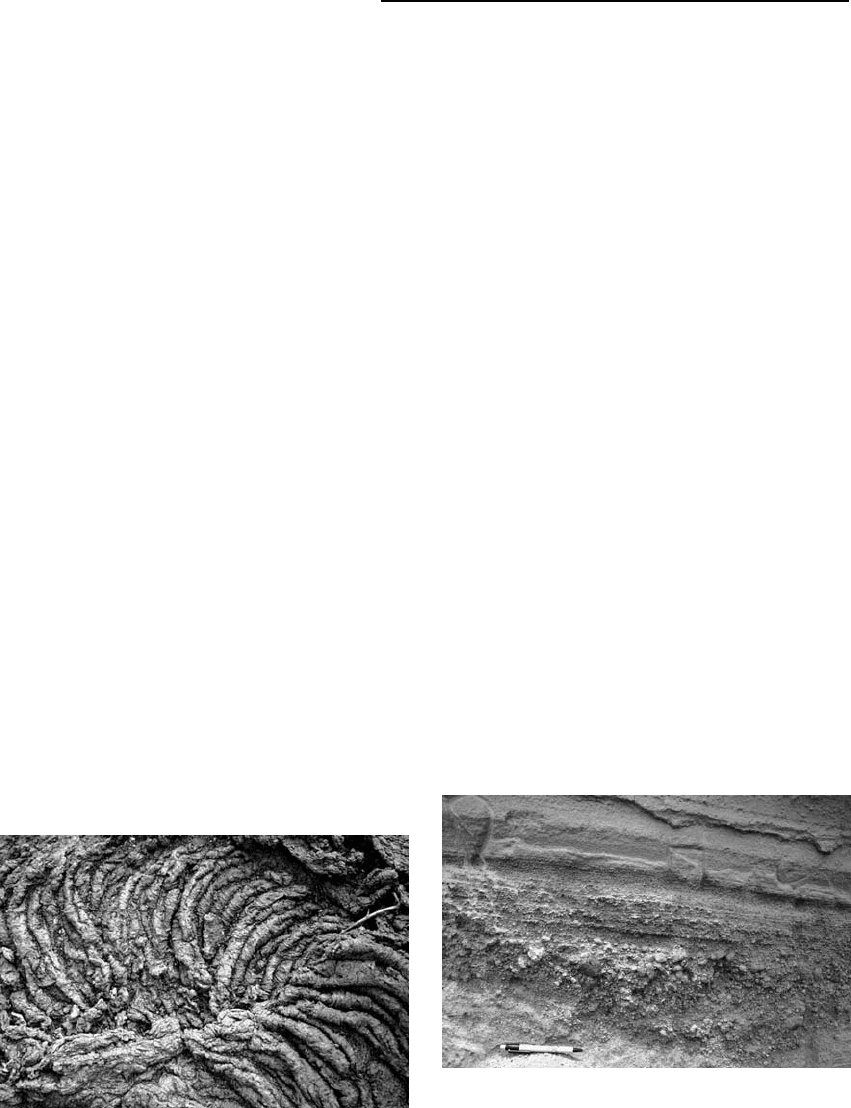
where the eruptions occur, and a number of different
eruption styles are recognised (17.3), each producing
a characteristic suite of volcanic rocks.
17.1.1 Lavas
Molten magma flowing from fissures normally has a
high viscosity and hence lava flows are laminar
(4.2.1). This may result in a banding within the flow
that is preserved when the lava cools and may be seen
in some lava flows with relatively high silica composi-
tions. On land, evidence for laminar flow may often be
seen near the edges of lava flows between a margin of
solidified lava, which forms a sort of levee, and the
central part of the flow that moves as a simple plug
with no internal deformation. Very fluid lavas may
develop a pahoehoe texture, a ropy pattern on the
surface (Fig. 17.1), whereas more viscous flows have
a blocky surface texture, known as aa: these features
may be preserved in the top parts of ancient flows. If
an eruption occurs under water the lava cools rapidly
to form pillow lava structures that are typically tens
of centimetres in diameter and provide a reliable indi-
cator of subaqueous eruption.
17.1.2 Formation of volcaniclastic material
Volcaniclastic material may be divided into fragments
that result from primary volcanic processes, that is,
those that are related to events during eruption and
movement of the material, and those that are a result
of secondary processes of weathering and erosion on
the land surface. Primary processes can be further
divided into those that are a part of the eruption,
producing pyroclastic material, and those that are
not related to the eruption event and are known as
autoclastic processes. The products of these pro-
cesses are volcanic blocks/bombs, lapilli and ash
depending on their size (3.7.2) and they solidify to
form agglomerate, lapillistone or tuff respectively
(Fig. 17.2).
Pyroclastic material
Fragmentation of volcanic material during eruption
can occur in a number of ways. Magmatic explo-
sions occur when gases dissolved in the magma come
out of solution as the melt rises to the surface and
decompresses (Orton 1996). The solubility of volatile
components decreases as the confining pressure falls
to reach the point where the vapour pressure equals
or exceeds the confining pressure. The sudden release
of the gases to form bubbles within the magma causes
both the gas bubbles and the melt to be violently
ejected through a fissure or vent. The expanding bub-
bles fragment the cooling magma and generate clasts
of pyroclastic material. Where this process occurs
underground in a shallow magma chamber explosive
failure of the roof of the chamber occurs when the
pressure within the magma exceeds the strength of
the rock above. The force of the explosion will then
incorporate the overlying rock that is fragmented
in the process. Explosive eruption also occurs
when ascending magma reacts with water: these
phreatomagmatic explosions happen when molten
rock interacts with groundwater, wet sediment with
Fig. 17.1 The ropy surface texture of a pahoehoe lava.
Fig. 17.2 Beds of volcaniclastic sediments: the lower layers
are coarse lapillistones while the upper beds are finer ash
forming tuff beds.
264 Volcanic Rocks and Sediments

shallow water in a lake or sea or under ice. They also
occur when a subaerial lava flow or hot pyroclastic
flow enters the water at the shoreline of the sea or a
lake (Cas & Wright 1987). Fragmentation occurs as
the water expands upon being heated and forming
steam interacting with the rapidly cooling magma.
Heating of water by volcanic processes to form
steam can also create enough pressure to fragment
surrounding and overlying rock, generating a phre-
atic explosion. Unlike phreatomagmatic explosions,
these phreatic explosions do not involve the formation
of fragments from molten magma. Phreatic and
phreatomagmatic eruptions are both types of hydro-
volcanic processes, occurring as a consequence of
the interaction of volcanic activity and water.
Autoclastic material
Fragmentation also occurs as a consequence of non-
explosive hydrovolcanic processes. The rapid cooling
of the surface of a lava flow in contact with water
results in quench-shattering and the creation of
glassy fragments of rock of various shapes and sizes.
This process can occur in shallow water but is found
often in lavas formed in deeper water where the pres-
sure of the overlying water column inhibits explosive
reactions (Cas & Wright 1987). These autoclastic
products are referred to as hydroclastites or more
specifically hyaloclastites, which are poorly sorted
breccias made up of fragments of volcanic glass
formed by the rapid quenching of a molten lava.
They often occur associated with pillow lavas, filling
in the gaps between the pillows. A second autoclastic
mechanism of fragmentation occurs during flow as
the surface of a viscous lava flow partially solidifies
and is then fractured and deformed as flow continues.
This flow fragmentation process is also referred to
as autobrecciation.
Epiclastic material
Epiclastic fragmentation of lava or ash deposits occurs
after the episode of eruption has finished. Weathering
processes (6.4) attack volcanic rocks very quickly,
particularly if it is of basaltic composition and made
up of minerals that readily oxidise and hydrolyse on
contact with air and water. The surface of an ash
layer or lava flow is therefore susceptible to break-
down and the formation of detritus that may be sub-
sequently reworked and redeposited to form a bed of
volcaniclastic sediment. There may be evidence of the
weathering processes in the form of alteration around
the edges of the clasts, and a degree of rounding of the
clasts will indicate that the debris has been trans-
ported by water. Other indications of an epiclastic
origin of a deposit may be the presence of clasts of
non-volcanic origin within the deposit, although it is
possible for pre-existing sediment to be included with
primary volcaniclastic deposits during eruption and
initial transport.
17.2 TRANSPORT AND DEPOSITION OF
VOLCANICLASTIC MATERIAL
There are some important differences between the
way that primary volcaniclastic material behaves
during transport and deposition and the terrigenous
clastic detritus considered in earlier chapters. An
important physical control on sedimentation is that
the settling velocity is proportional to fragment size,
shape and density (4.2.5). Unlike terrigenous clastic
material, the density of pyroclastic particles is very
variable. In particular pumice pyroclasts may have a
very low density and can float until they become
waterlogged (Whitham & Sparks 1986). Grading in
pyroclastic deposits may show both normal and
reverse grading of different components in the same
bed. Lithic fragments and crystals will be normally
graded, with the coarsest material at the base. Pumice
pyroclasts deposited in water may be reverse graded
because the larger fragments will take longer to
become waterlogged and hence will be the last to be
deposited, resulting in reverse grading. Three primary
modes of transport and deposition are recognised:
falls, flows and surges, but it should be noted that all
three can occur associated with each other in a single
deposit.
17.2.1 Pyroclastic fall deposits
When an explosive volcanic eruption sends a cloud of
debris into the air the pyroclastic fragments may
return to the ground under gravity as a shower of
pyroclastic fall deposits. Volcanic blocks and
bombs travel only a matter of hundreds of metres to
kilometres from the vent, depending on the force with
which they were ejected. Finer lapilli and ash may
be sent kilometres into the atmosphere and be
Transport and Deposition of Volcaniclastic Material 265
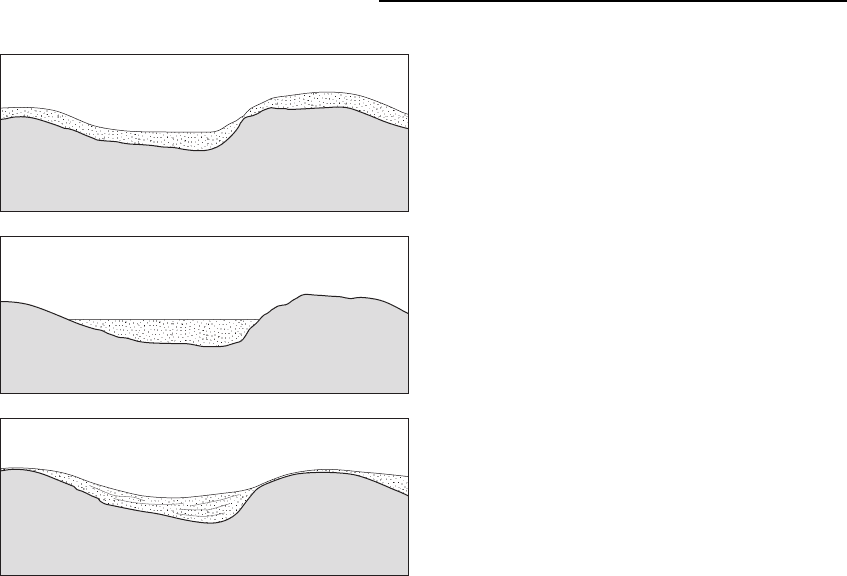
distributed by wind, and large eruptions can result in
ash distributed thousands of kilometres from the vol-
cano. A distinctive feature of air-fall deposits is that
they mantle the topography forming an even layer
over all but the steepest ground surface (Fig. 17.3).
The deposits become thinner and are composed of
finer grained material with increasing distance from
the volcanic vent. Pyroclastic falls range in size from
small cinder cones to large volumes mantling topo-
graphy over large areas.
17.2.2 Pyroclastic flows
Mixtures of volcanic particles and gases can form
masses of material that move in the same way as
other sediment–fluid mixtures, as sediment gravity
flows (4.5), and if they have a high concentration of
particles they are referred to as pyroclastic flows
(Fig. 17.3) (cf. pyroclastic surges, which are lower
density mixtures). Pyroclastic flows can originate in
a number of ways, including the collapse of a vertical
eruption column of ash, lateral or inclined blasts from
the volcano, and the collapse of part of the volcanic
edifice. They may move at very high velocities, up
to 300 m s
1
, and can have temperatures of over
10008C: a pyroclastic flow made up of a hot mixture
of gas and tephra is sometimes referred to as a nue
´
e
ardente, a ‘glowing cloud’ (Cas & Wright 1987).
Flows that contain a high proportion of large clasts
form block- and ash-flow deposits: these poorly
sorted agglomerates have a monomict clast composi-
tion and cooling cracks in the blocks may indicate
that they were hot when deposited. Scoria-flow
deposits are a mixture of basaltic to andesitic ash,
lapilli and blocks that are poorly sorted and com-
monly show reverse grading. An ignimbrite is the
deposit of a pyroclastic flow composed of pumiceous
material that is a poorly sorted mixture of blocks,
lapilli and ash. Ignimbrites commonly contain frag-
ments that are hot enough to fuse together when
deposited and form a welded tuff, but it should be
noted that not all pumice-rich flow deposits are
welded. In general pyroclastic flow deposits do not
show sedimentary structures other than normal or
reverse grading and the poorly sorted character
reflects their deposition from relatively dense flows.
17.2.3 Pyroclastic surges
Low concentrations of particles in a sediment gravity
flow made up of volcanic particles and gas are known
as pyroclastic surges (Fig. 17.3), and are distinct
from pyroclastic flows because of their dilute nature
and turbulent flow characteristics (Sparks 1976;
Carey 1991). Phreatic and phreatomagmatic erup-
tions commonly generate a low cloud made up of a
low-density mixture of volcanic debris and fluids,
known as a base surge: both ‘wet’ and ‘dry’ base
surges are recognised, depending on the amount of
water that is involved in the flow. They travel at high
velocity in a horizontal direction away from the erup-
tion site. The deposits of base surges are typically
stratified and laminated with low angle cross-stratifi-
cation formed by the migration of dune and antidune
bedforms. Accretionary lapilli (3.7.2) are a feature of
‘wet’ base surges and near to the vent large volcanic
bombs may occur within the deposit. The thickness of
a base surge varies from as much as a hundred metres
close to a phreatomagmatic vent to units only a few
centimetres thick further away.
Pyroclastic fall deposits
mantle topography except steep slopes
Pyroclastic flow deposits
confined to valleys
Pyroclastic surge deposits
occur over topography, thicken in valleys
Fig. 17.3 Distribution of ash over topography from pyro-
clastic falls, pyroclastic flows and pyroclastic surges.
266 Volcanic Rocks and Sediments
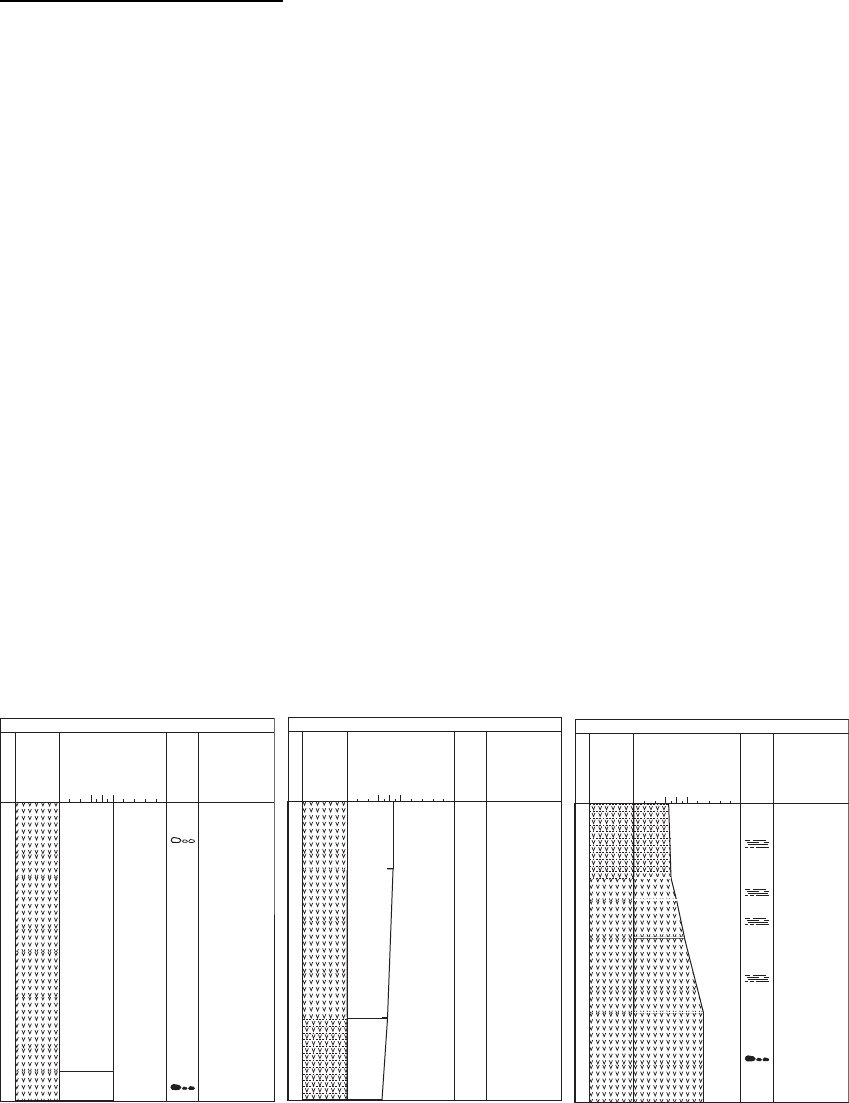
It is common for low-density surges to occur asso-
ciated with a high-density pyroclastic flow, either as a
precursor to the main flow, and hence forming a
deposit underlying the flow unit (a ground surge
deposit), or (and) as an ash-cloud surge that forms
at the same time as a flow but above it and depositing
a surge deposit on top of the flow unit. Ground-surge
deposits at the base of flow units are normally less
than a metre thick and are typically stratified, includ-
ing cross-stratification. At the tops of pyroclastic flow
units ash-cloud surges also form thin stratified
and cross-stratified beds of ash-size material. They
form by dilution by mixing with air at the top of a
flow and hence contain the same clast types as the
underlying flow. An ash-cloud surge has similar char-
acteristics to a turbidity current but instead of the
clasts mixing with water, the ash is in a turbulent
suspension of gas.
17.2.4 Pyroclastic flow, surge
and fall deposits
A single eruption event may result in a combination
of surge, flow and fall deposits (Fig. 17.4). Block- and
ash-flow deposits lack the ground-surge unit that may
be seen at the bottom of scoria-flow and ignimbrite
deposits. Pyroclastic flow units are typically structure-
less, although they may display some grading, with
reverse grading occurring in the lower density pumice
and vesiculated scoria fragments and normal grading
in the more dense lithic clasts. The process of elutria-
tion, the mixing of the upper part of the sediment
gravity flow with the surrounding air and volcanic
gases, leads to a dilution and formation of a turbulent
ash-cloud surge. Bedforms created by the flow result
in cross-stratification as well as horizontal lamination
in the deposits. Flow units are commonly capped by
air-fall deposits that show no depositional structures.
A depositional feature that is quite commonly
found in pyroclastic deposits but is very rare in terri-
genous clastic sediments is the presence of antidune
cross-bedding (4.3.4). Antidunes may form in many
high velocity flows, but are normally destroyed as the
flow velocity decreases and the sediment is reworked
to form lower flow regime bedforms (4.3.6). Preserva-
tion of antidunes occurs when the rate of sedimenta-
tion from the flow is high enough to mantle the
bedform before it can be reworked, and this occurs
where there is volcaniclastic material entrained in a
turbulent gravity flow in air (Schminke et al. 1973).
The cross-stratification of antidunes dips in the oppo-
site direction to dune cross-stratification, that is, it is
directed in an up-flow direction.
cm - m
MUD
clay
silt
vf
SAND
f
m
c
vc
GRAVEL
gran
pebb
cobb
boul
Pyroclastic fall deposits
Scale
Lithology
Structures etc
Notes
cm - m
MUD
clay
silt
vf
SAND
f
m
c
vc
GRAVEL
gran
pebb
cobb
boul
Pyroclastic flow deposits
Scale
Lithology
Structures etc
Notes
cm - m
MUD
clay
silt
vf
SAND
f
m
c
vc
GRAVEL
gran
pebb
cobb
boul
Pyroclastic surge deposits
Scale
Lithology
Structures etc
Notes
Pyroclastic fall
deposits.
Pumice
concentrated
near the top and
lithic clasts near
base.
Pyroclastic flow
deposits. May
show inverse
grading and
vertical gas
pipes.
Pyroclastic
surge deposits.
Normally graded
and stratified,
sometimes
cross-stratified.
Fig. 17.4 Sketch graphic sedimentary logs of pyroclastic fall, flow and surge deposits.
Transport and Deposition of Volcaniclastic Material 267
